117 Search Results for corner
December 2, 2014
by Carole Zangari -
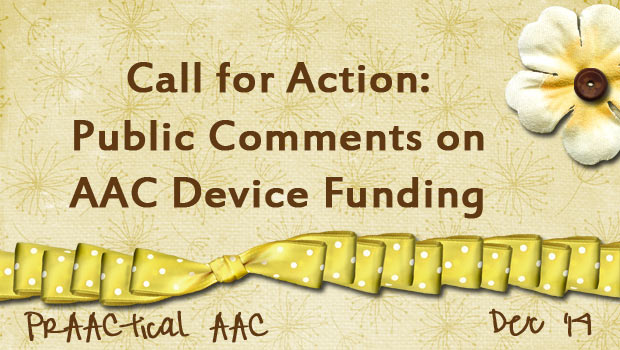
Chances are that most of our US-based SLPs have heard about the funding challenges with Medicare. We now have only a few more days to make our voices heard to support clients with AAC needs. If you haven’t already submitted public comment, please take the time to help in these advocacy efforts. Medicare (CMS) currently is reconsidering its National Coverage Decision (NCD) for Speech Generating Devices (SGDs). As part of that process, CMS will allow interested members of the public to submit comments about future Medicare SGD coverage until December 6, 2014. The information that follows was prepared by the Medicare Implementation Team, an ad hoc group of AAC clinicians, researchers, advocates, educators, manufacturers, etc., many of whom worked on the 2001 NCD. FOLLOW THESE 5 SIMPLE STEPS TO SUBMIT A COMMENT TO CMS. 1. Review the 8 PROPOSED COMMENT AREAS below that are critical to include in a revised NCD for... [Read More...]
September 4, 2014
by Carole Zangari -
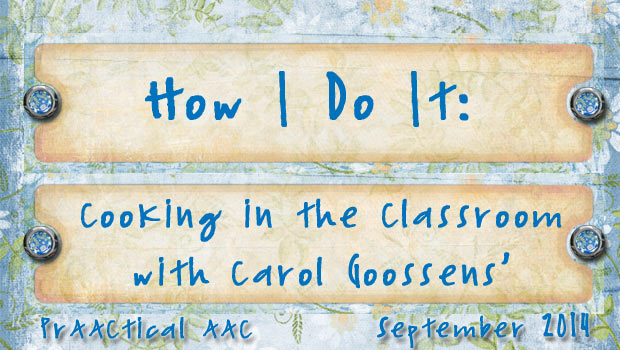
There is something about fall that puts us in the mood for cooking. Today, we are honored to learn from an AAC pioneer, Dr. Carol Goossens,’ who is an SLP and special educator based in the New York City area. She has consulted extensively in a variety of classrooms serving the full spectrum of children with special needs. Carol has presented both nationally and internationally about her collaborative work with teachers, therapists and families. She is known for her ability to seamlessly integrate technology in the classroom and for developing innovative ways to help children learn …while having fun doing it! In this post, she shares one of her latest projects, making animated recipes for using in cooking activities in the classroom. Cooking appears to be motivating for most children … the magic of putting together ingredients that ultimately become something delicious to eat. Teachers, speech-language pathologists (SLPs) and occupational therapists (OTs) often use food preparation activities... [Read More...]
May 27, 2014
by Carole Zangari -
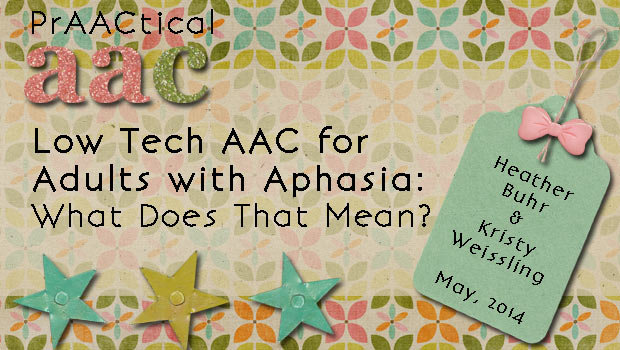
Aphasia Awareness Month is just around the corner, and getting us ready for that is this wonderful post on using low tech AAC with people who have aphasia. We’re delighted to welcome back our friend and colleague, Dr. Kristy Weissling, who is collaborating with Heather Buhr, to share some thoughts on this topic. ::::::::::::::::::::::::::::::::::::::::::::::::::::::::::::: For many, the term Augmentative and Alternative (AAC) brings to mind technology, speech-generating devices, and now – more than ever before – iPads. But as we know, AAC encompasses much more than that. We all use AAC when we make facial expressions or gestures, use symbols or pictures, or write. We would like to explore AAC and more “low-tech” options that help our clients express their thoughts, needs, wants, and ideas. Low-tech strategies can range from the use of written choice, to communication boards, to communication books. In this article we will specifically address communication... [Read More...]
May 26, 2014
by Robin Parker -
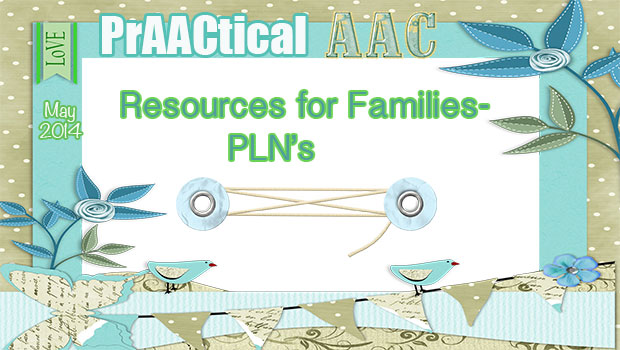
This month’s ‘Strategy of the Month’ has been focused on supporting families. To fully support families, it is essential to provide family friendly resources that can aid in creating Personal Learning Networks (PLN’s). The more families know and learn, the more likely the AAC learner will progress in their communication skills. Also, the more information families have, the better advocates they will become. And since families are one of the only constants in an AAC learner’s educational and life journey, the family is really the most important part the communication team. About AAC About AAC- ASHA AAC Institute- Parent’s Corner Center for AAC & Autism AAC -Family Resources Assistive Technology Resources- Autism Speaks Communication Matters Communication Books & Boards ConnectAbility http://www.setbc.org/pictureset/ Pre-made Communication Boards Help Designing Communication Books Free & Discounted AAC Apps Appy Malls Smart Apps for Kids Moms with Apps The iMums Apps Wheel *(categorized wheel of apps to... [Read More...]
March 24, 2014
by Robin Parker -
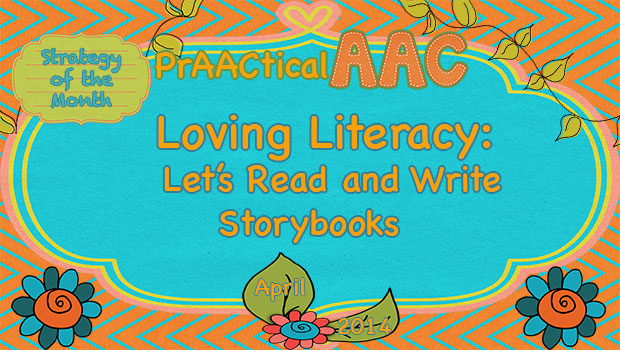
Literacy instruction involves lots of reading and writing. Last week, Carole discussed using storybook reading and the RAAP (Read, Ask, Answer, Prompt) strategy by Drs. Cathy Binger and Jennifer Kent-Walsh to teach communication and literacy. To use storybooks with all learners we need to have lots of books that are easily accessible. Books need to be accessible physically as well as through content and interest. It is lucky that with all of today’s on-line resources there is an abundance of ways to obtain as well as make and write storybooks. All learners can and should be be involved in both the reading and writing process. Not only do literacy skills improve but so do communication skills. Involving Learners in the Storybook Process Reader & Writer Vocabulary- Facilitate involvement by using reader and writer vocabulary. Refer to learners as “readers”, “authors”, “editors”, “publishers”, “critics”, etc. When you are treated and referred... [Read More...]
March 6, 2014
by Carole Zangari -
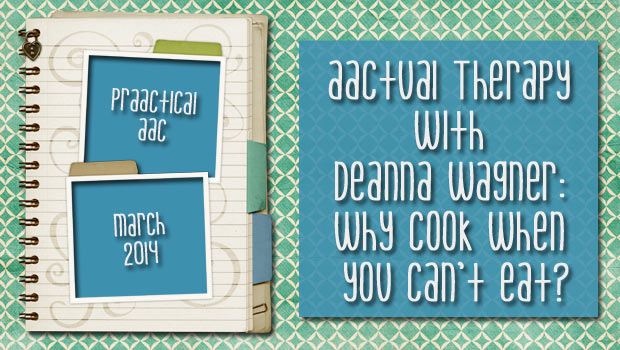
One of our prAACtical friends loves to think about, talk about, and participate in anything to do with baking. Not all that unusual unless you consider that he has a g-tube and doesn’t eat in the conventional sense. So we were incredibly excited have this guest post by SLP Deanna Wagner, whose prAACtical ideas for teaching AAC using cooking activities appealed to us right away. You can read more about Deanna here. Why Cook When You Can’t Eat? I have been thinking about writing this post for a number of weeks, now. And have come up with many different answers to this question, “Why cook when you can’t eat?” I finally decided I should just talk about how we use cooking activities to reinforce communication skills and let the reader can come up with his/her own answer to this question. Whether I am working in a school classroom or with adults... [Read More...]
December 26, 2013
by Carole Zangari -
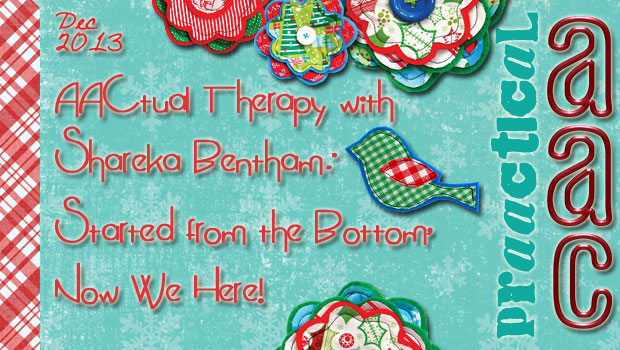
We’re so thrilled to have Shareka Bentham back as an AACtual Therapist, this time talking about her journey into high tech AAC. You can see other posts from Shareka here. One of our colleagues completed the AAC evaluation on a client of Shareka’s. While preparations for that evaluation were underway, we were fortunate enough to learn of an AAC device that was no longer needed. The family agreed to donate it to this little fellow, and that seems to have launched a whole chain of prAACtical events. Shareka takes it from here… Sadly, this is not the first step into my career as a rapping superstar, but more a description of my journey from ‘no tech’ to high tech in AAC use. If someone had told me a year ago that I would be showing off my skills on a high tech AAC device, and teaching children, parents, and teachers... [Read More...]
September 28, 2013
by Robin Parker -
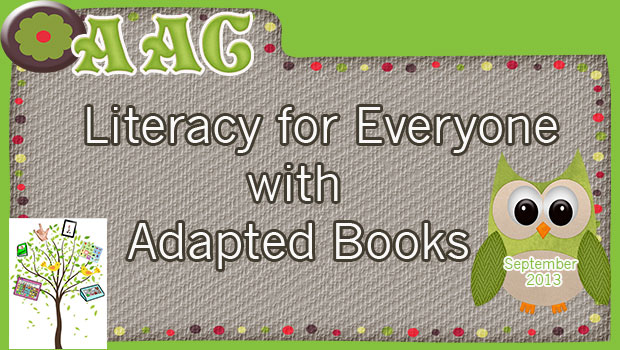
To integrate reading and writing into communication & language learning we need to have lots of books that are easily accessible. Books should be accessible physically as well as through content and interest. This holds true for ALL learners even those that don’t like books but do like…… wheels. We have made literacy accessible for a young girl who only liked elevators, and a boy who only liked balls, and a young adult who liked Barney books but not much else. It holds true for ALL disabilities, and ALL levels of reading and writing. For our final September Literacy Strategy of the Month, we wanted to share the abundance of resources for making adapted books. Because when we have great adapted books, literacy is more accessible. Check out these awesome resources for making your own adapted books and for printing out already created adapted books and lessons. We love early... [Read More...]
June 27, 2013
by Robin Parker -
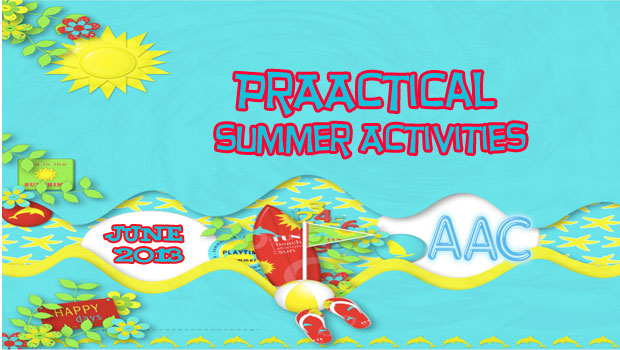
It’s summer time and hopefully you have some time for some fun meaningful language experiences. There are many resources to help prAACtically support many summer time traditional activities. Check these out: Swimming– Special Education British Columbia- Picture Set has a great visual support for pool routines. Tammy Anderson from Aqua Pros Swim School shares Innovative and Fun Visual Supports for teaching swimming. Cooking– Recipes visualized from Dade County Schools (need boardmaker software to open) OR Recipes visualized from Your Special Chef (no boardmaker necessary) Bubbles are a great outdoor activity for the summer. SLP Tanna Neufeld shares her ideas and communication displays to make bubbles a meaningful language learning experience. Nature Walks- Visual checklists help make nature walks meaningful language experiences. The checklist provides a visual organization that can build in symbol/language learning as well as providing an easy way to talk about the event after it is over. Check Lakeshore... [Read More...]
June 13, 2013
by Carole Zangari -
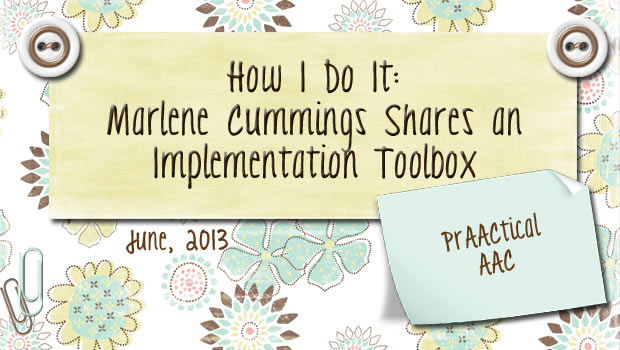
Now that the school year is winding down, some of you have a little more time to read, process, and prepare for next year. We are really excited to share more ideas from Marlene Cummings, one of the most experienced AAC SLPs that we know. Those of you who have been following Marlene’s posts on the AAC implementation will be pleased to see the next part of the Framework for Success that she developed with the AAC Team at Oakland School District. If you missed her first and second posts, go take a peek at them when you can. 5 Things in our “Implementation Toolbox” When we begin the process of implementing AAC it is important to consider our “thinking”. We always want to approach every student, every team and every classroom with as much wisdom and respect as possible. One of my colleagues, Dr. Penny Hatch, from UNC Chapel Hill... [Read More...]









